The Army and Marine Corps have started to reduce their ground forces in Iraq in response to a reduction in violence, but Air Force officials expect no relief for the growing number of airmen chipping in to help the land forces there.
Top Air Force officials say they assume they will have to provide an equal or perhaps a slightly higher number of airmen to fill “nontraditional” ground jobs. This is true, they say, not only in Iraq but also in Afghanistan. These officials expect USAF’s commitment to continue well into next year.
The steady state assignment of more than 6,000 airmen to these tasks—called “in lieu of” missions, in that they have been assigned to airmen in lieu of soldiers and marines—will likely persist even though the Army and Marine Corps are raising end strength and the Air Force is cutting its.
The ILO taskings also continue despite Air Force charges that well-trained personnel are being put to poor use.
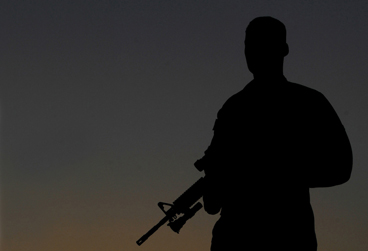 |
Amn. Kevin Cook stands watch at Ali Air Base, Iraq. (USAF photo by A1C Jonathan Snyder) |
The Air Force has been sending its airmen to Iraq, Afghanistan, and elsewhere in the US Central Command theater to perform ILO taskings since February 2004. They have been performing a variety of tasks normally handled by soldiers or marines. Those requirements came in response to Pentagon concerns that the ground services were being overstressed from repeated combat deployments and shortened periods at home bases.
The assignments come in addition to the normal Air Force deployments in support of the war against extremists.
Of the 25,453 airmen deployed to the theater late last year, 6,293 were filling ILO taskings, Maj. Gen. Marke F. Gibson, Air Force director of operations, told a House Armed Services readiness subcommittee.
That number is up from about 5,100 in 2006 and is expected to remain “relatively stable” under current plans, said Col. Gregory A. Kern, commander of the Air Force Operations Group.
The ILO requirement this year is expected to be in the range of 6,000 to 6,600, Kern said. And the preliminary work on the 2009 joint force management plan indicates a requirement for 6,500 to 6,600, he said.
Those CENTCOM requirements persist despite a declaration from Gen. T. Michael Moseley, Air Force Chief of Staff, that he would resist further requests for airmen to fill Army or Marine Corps jobs that fall outside airmen’s core competencies.
“We live in a joint world,” said Moseley. “We live in a military that’s at war and we are in a situation where, if we can contribute, sign me up for that,” Moseley said. However, he was much less enthusiastic about certain types of ILO assignments, such as Air Force security personnel guarding detainees in Iraq.
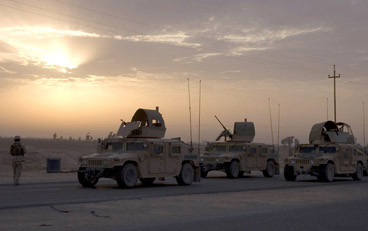 |
Members of the 887th Expeditionary Security Forces Squadron patrol a convoy route, searching for improvised explosive devices. (USAF photo by SSgt. Raymond Mills) |
“We don’t guard prisoners; we don’t even have a prison,” Moseley said. Making airmen guard prisoners takes them away from their normal Air Force jobs for time to train, more time to deploy, and then time to get back into their old work, he said.
In October, Moseley indicated that the Air Force was approaching a limit to its ability to support the ILO requirements, because of its ongoing personnel reductions.
Although the Air Force will continue to contribute to the joint fight, the Chief said, “as we get closer to 316,000 [troops; that is the current USAF end strength target], the capacity of the Air Force to offer up this kind of help will diminish down to about zero.”
The general said he did not object to airmen performing ground duties that they are trained to do, such as driving supply trucks. With its Air and Space Expeditionary Force rotations, the Air Force can put qualified drivers on the job quickly if needed. And the Air Force does so when asked, Moseley said.
Something Completely Different
However, because of the time it takes to select and train an airman for a requested job, the situation on the ground may have changed by the time the ILO airman arrives on the scene. The airman may then end up doing something completely different for CENTCOM, which is a waste of skill and effort.
Moseley also said that he has a problem with the term “in-lieu-of tasking.” Being in lieu of anything implies that airmen are just sitting around waiting for something to happen. They actually have full-time day jobs and are critical contributors to other Air Force missions “that are now not being met” because airmen are “out doing something outside that task.”
Gibson made the same point to the House committee, noting that when airmen perform duties outside of their core competencies, it costs money to train them and undercuts their primary mission and the missions of the Air Force. “We are proud to be part of this joint fight,” he said, “but we would like to continue to get back into those functions that are matched with our core competencies within the Air Force.”
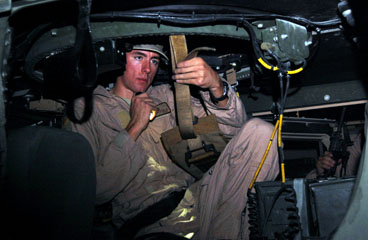 |
A1C Byron Mcguire, a gunner with the 887th Expeditionary Security Forces Squadron, inspects the straps on his vehicle’s turret seat before a convoy mission in Iraq. (USAF photo by SSgt. Phillip Butterfield) |
Kern said ILO assignments stem from requirements from a combatant command—in this case, US Central Command—for a particular mission set or capability. “As the request for forces is in development, Joint Forces Command (JFCOM) will identify a preferred force provider,” such as the Army, he said.
If the Army determines it cannot fill that requirement within the rules set by the Defense Secretary for conditions such as the ratio between deployments and dwell time at home, it will tell JFCOM, Kern explained.
JFCOM then asks the other services if they can meet the requirement and, if so, at what risk to their own functions.
The key point, Kern emphasized, is that ILOs are not filling Army requirements—they are a “combatant commander, a joint warfighting, requirement.”
If the requirements come to the Air Force, “we look at who’s in the AEF bucket, who’s ready to deploy, who has been trained to deploy,” said Kern. “Those are the folks who can be assigned.”
Most ILO tours last 179 days, with some up to 365 days, based on the requirements. Despite the concerns about individuals working outside their specialties, Kern said “greater than 90 percent of the airmen out there doing in-lieu-of missions are within … their core competency.”
He also said the ILO assignments are nontraditional jobs, first and foremost. Airmen are “doing a lot of training team activities, doing provisional reconstruction team activity, teaching the Iraqis and Afghans how to operate inside our concept of a modern military structure.” Airmen also are working on mobility or logistic teams and are conducting “some convoy activities.”
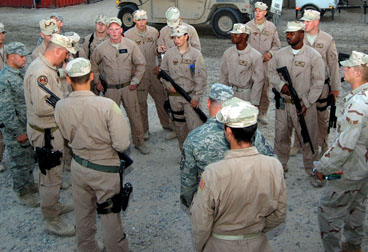 |
Airmen at Camp Bucca, Iraq, are briefed before the start of a convoy. They are deployed from Barksdale AFB, La.; Nellis AFB, Nev.; Lackland AFB, Tex.; and Moody AFB, Ga. (USAF photo by SSgt. Phillip Butterfield) |
Asked about the apparent conflict between working within a “core competency” but doing “nontraditional jobs,” Kern used the example of airmen who are trained as heavy equipment operators or big truck drivers, but for “the expected mission set for an Air Force vehicle operator.”
If those airmen are tasked as ILOs, “they already have the basic skills it takes to drive the vehicle, to operate the vehicle safely on the battlefield,” he said.
What the airmen probably lack is knowledge of how to operate that vehicle in a convoy with 10 or 12 or 100 other vehicles. The Army terminology, command and control architecture, and tactics, techniques, and procedures all must also be learned, especially as drivers face a high risk of coming under attack.
Bridging the Training Gaps
The Navy also has been helping to relieve the burden on the two ground services, sending sailors to perform ground jobs in the heat and sand of Iraq and Afghanistan. When he was Chief of Naval Operations, Adm. Michael G. Mullen, now Joint Chiefs of Staff Chairman, actively supported the use of what the Navy calls individual augmentees (IAs) to replace soldiers and marines. With about 10,000 sailors ashore, including 8,000 IAs, the Navy has more “boots on the ground” than at sea in the CENTCOM region.
Every airman selected for an ILO deployment will go through one of 32 sets of specialized combat skills training to make him or her “combat effective” in the environment the airman will deploy to.
The combat training takes place at one of eight Army posts and can run from several weeks to several months, Kern said. It is conducted by Army instructors, but the syllabus is put together and “managed as a kind of joint operation” between USAF’s 2nd Air Force and the Army.
During that training, the airmen are under the command of an airman. They train as a unit and deploy as a unit, the colonel said.
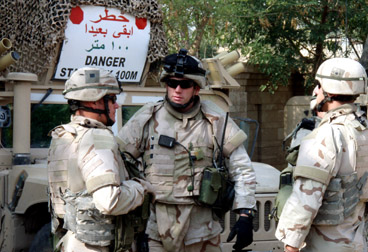 |
Left to right, TSgt. William Duffy, SSgt. Justin Geers, and SSgt. James Arent, all deployed from Moody AFB, Ga., prepare for a patrol in Iraq. (USAF photo) |
The curriculum includes training in weapons, advanced first aid, Army terminology, command and control, how to operate wearing body armor and helmets—“all the combat skills they need to be combat effective, given the location,” he said.
The training requirements are developed by 2nd Air Force experts and reviewed regularly by the Army to meet the specific task and location, he continued.
“We don’t have one-size-fits-all training,” Kern said.
Second Air Force assembled more than 40 functional experts to serve as the in-lieu-of Training and Equipment Review Board (TERB) at Keesler AFB, Miss., in March. The board validated the requirements for airmen performing the ground missions.
Acknowledging that Army training differs from Air Force training in culture, content, and delivery, the TERB members have “made great strides bridging the gaps—thus ensuring airmen are postured for success,” said Maj. Gen. Michael C. Gould, 2nd Air Force commander, in an Air Force release.
No Career Damage
However, Gen. William R. Looney III, commander of Air Education and Training Command, complained last September that there are still “some severe disconnects” in the ILO training. “The Air Force needs to get a better grip on what the taskings are, where the airmen are heading, and whether they are getting the proper training,” Looney said.
Kern said 70 percent of USAF’s ILOs are in Iraq, with the remainder serving in Afghanistan or elsewhere in the CENTCOM theater.
Eighty-five percent of the ILOs are enlisted and 15 percent are officers.
Some ILO requirements are filled through mandatory assignment, although some airmen have volunteered for the jobs, and Kern said the Air Force is working hard to ensure that no airman’s career suffers because of an ILO assignment.
USAF has found that when airmen return from an ILO assignment, “they are extremely competitive, highly charged, and they do very, very well when they compete with their peers who have not deployed” for an ILO experience, he said.
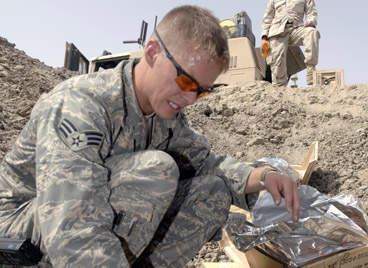 |
SrA. Jonathan Sheridan prepares C-4 explosives at Ali Air Base for a controlled detonation of confiscated weapons. Sheridan was assigned to the 407th Civil Engineer Squadron’s explosive ordnance disposal team. (USAF photo by MSgt. Robert Valenca) |
The airmen come back with “a great understanding of joint operations,” Kern added. “They have a great understanding of Army terminology, Marine terminology, how a joint force fights. They have experiences that few other airmen will have.”
If an airman misses a promotion test or a training opportunity due to an ILO deployment, a process is in place that allows the Air Force to make up for that. Airmen “are not put at a disadvantage because of their contribution to the overall war,” Kern stressed.
There is, however, a potential impact from the unusual duties in a combat zone that the Air Force cannot reverse—the heightened risk of death or injury.
Kern said the Air Force could not distinguish ILO casualties from those suffered doing traditional tasks. It is likely, though, that ILO assignments “outside the wire” account for some of the airmen killed in action and wounded in Iraq and Afghanistan.
Despite the complaints about how some ILO airmen are employed, the Air Force is committed to the program because “the No. 1 priority is to win this Global War on Terror,” Kern said. Moseley has said a number of times, “It’s really not about the Air Force or the Army, or the Navy, or the Marine Corps. It’s about winning this fight.”
Kern has heard back from the leadership that has gone out to the AOR to visit these airmen and from the deployed commanders, and they say “these airmen are appreciated, they’re valued. There is a demand for them because … they’re smart, and they like being a part of something that will define this generation and this century.”
Otto Kreisher is a Washington, D.C.–based military affairs reporter and a regular contributor to Air Force Magazine. His most recent article, “Seven New Carriers (Maybe),” appeared in the October 2007 issue.